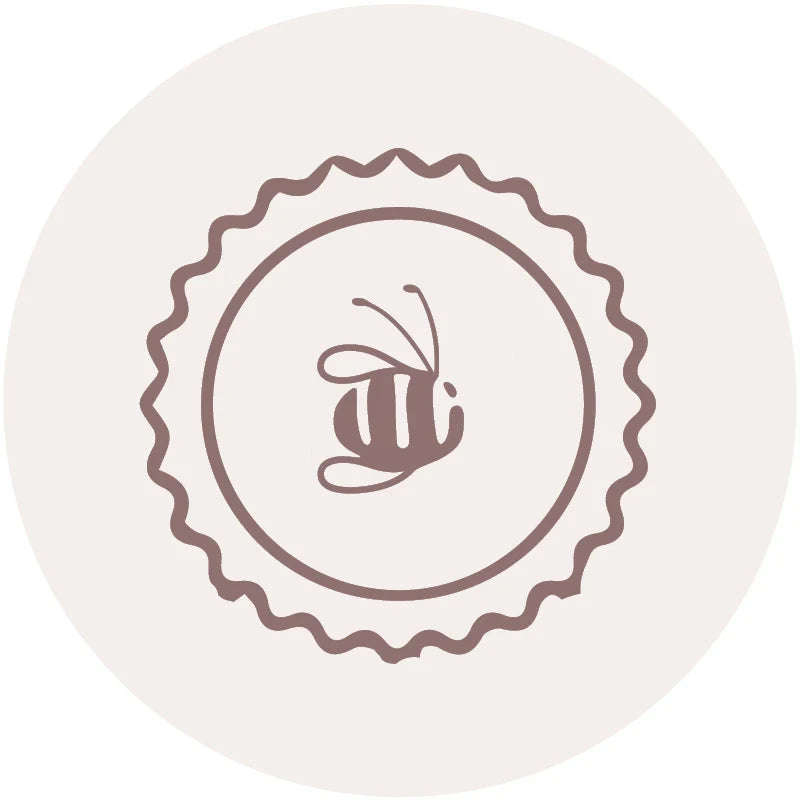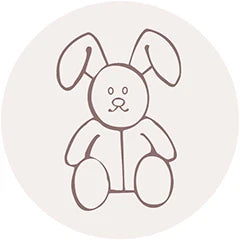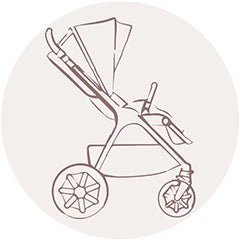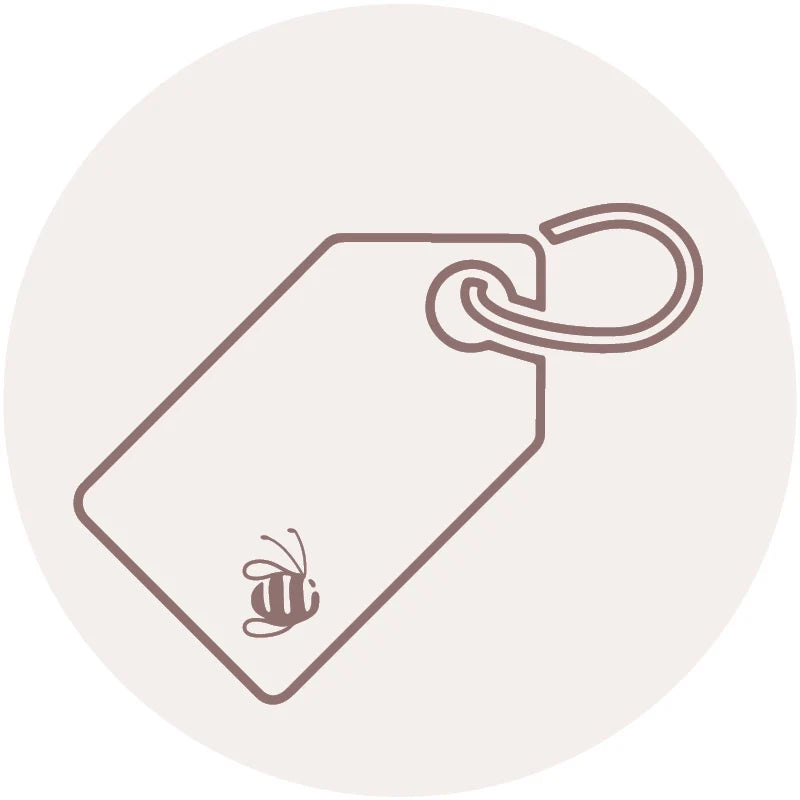NUK for Nature Learner Sippy Bottle
NUK for Nature Learner Sippy Bottle
SKU:10528582
Clothing Prem to 18 Months
| Size | Age Guide | Weight | Height |
|---|---|---|---|
| Premature | Premature or Small Newborn | Up to 4Kg | Up to 55cm |
| Newborn | 0-3 months | 4-6Kg | Up to 62cm |
| 3 Month | 3-6 months | 6-8Kg | Up to 68cm |
| 6 Month | 6-12 Month | 8-10Kg | Up to 76cm |
| 12 Month | 12-18 Month | 10-12Kg | Up to 84cm |
| 18 Month | 18-24 Month | 12-14Kg | Up to 92cm |
Clothing 2 to 6 Years
| Size | Age Guide | Height | Chest | Waist | Hip |
|---|---|---|---|---|---|
| 2 Year | 2-3 Years | Up to 100 cm | 56 | 51 | 58 |
| 3 Year | 3-4 Years | Up to 105 cm | 58 | 53 | 60 |
| 4 Year | 4-5 Years | Up to 110 cm | 60 | 55 | 62 |
| 5 Year | 5-6 Years | Up to 115 cm | 62 | 57 | 64 |
| 6 Year | 6-7 Years | Up to 120 cm | 64 | 59 | 66 |
Beanie Size Guide
| Size | Head Circumference | Age Guide |
|---|---|---|
| Premature | 31-35 cm | Premature or Small Newborn |
| Newborn | 35-40 cm | Newborn |
| Small | 40-43 cm | 3-6 Months |
| Medium | 43-47 cm | 6-18 Months |
| Large | 47-52 cm | 18-3 Years |
Sunhat Size Guide
| Size | Head Circumference | Age Guide |
|---|---|---|
| Newborn | 37-40 cm | Newborn |
| Small | 40-43 cm | 3-6 Months |
| Medium | 43-46 cm | 6-12 Months |
| Large | 46-49 cm | 12-24 Months |
| Xtra Large | 49-54 cm | 2-4 Years |
Sleep Pods Size Guide
| Size | Weight | Age Guide | Measurement(Back to Hem) |
|---|---|---|---|
| Newborn | 0-6 kgs | 0-3 Months | 60.5 cm |
| Small | 0-8 kgs | 3-6 Months | 66 cm |
Booties Size Guide
| Size | Age Guide |
|---|---|
| Newborn | 0-3 Months |
| Small | 3-6 Months |
| Medium | 6-12 Months |
| Large | 12-18 Months |
Pretty Brave Baby
| Foot Length (mm) | Insole Length (mm) | EU | UK | Age | INT |
|---|---|---|---|---|---|
| 95-104 | 110 | 16/17 | 2 | 0-6m | S |
| 104-114 | 118 | 18 | 3 | 6-12m | M |
| 114-123 | 127 | 19/20 | 4.5 | 12-18m | L |
| 123-137 | 142 | 21/22 | 5.5 | 16-22m | XL |
Pretty Brave 1st Walker
| Foot Length (mm) | Insole Length (mm) | EU | UK | Age |
|---|---|---|---|---|
| 114-120 | 125-128 | 19 | 3 | 1 yr |
| 120-126 | 132-135 | 20 | 3.5 | 1-2 yrs |
| 126-132 | 138.5-141.5 | 21 | 4.5 | 1-2 yrs |
| 132-138 | 145-148.5 | 22 | 5 | 2 yrs |
Crywolf Swim Nappy
| Size | Length (waist to crotch) | Crotch Width (side to side) |
|---|---|---|
| 0-1 yr | 1-2 yrs | |
| 37 | 38 | |
| 14.5 | 15.5 |
Crywolf Rash Suit
| Size | Length (back neck to crotch) | Chest (arm to arm) | Waist (side to side) | Sleeve (neck to cuff) | Neck Opening(diameter) |
|---|---|---|---|---|---|
| 6-12 Months | 1 yr | 2 yrs | 3 yrs | ||
| 40 | 42 | 44 | 46 | ||
| 25 | 26 | 27 | 28 | ||
| 24 | 25 | 26 | 27 | ||
| 30 | 31.5 | 33 | 34.5 | ||
| 13.25 | 13.25 | 13.8 | 14.3 |
In stock
Couldn't load pickup availability
Overview
Overview
The NUK for Nature Learner Bottle is designed to make the transition from bottle to independent drinking easy and comfortable.
Made from 100% sustainable materials, it features soft, ergonomic handles for little hands and a leakproof lid, making feeding and learning to drink hassle free. The organically shaped teat, inspired by nature, has a rounded top and flat underside that nestles comfortably against your baby’s palate while allowing natural tongue movements. The integrated Anti-Colic Air System helps reduce swallowed air and a Temperature Control indicator provides an extra safety check, turning from blue to white if the contents are too hot.
Key Features
Key Features
Technical Specification
Technical Specification
Delivery and Returns
Delivery and Returns
- Delivery: Free within NZ on orders over $100 (excluding bulky items) or $8 standard shipping
- Returns: Accepted within 14 days of receipt with proof of purchase
- Some items are excluded from returns including sale items, hardware, car seats, prams, monitors and personal items - please click here for the full list.
Share this product
Recently Viewed Products
Related Blogs
A Guide to Baby's Temperature
As a parent there always seems to be something to worry about! A common concern in these cooler months is baby’s temperature and how to hit the ‘Goldilocks’ sweet spot – not too cold; not too hot! Monitoring baby Babies can’t regulate their own body temperature for the first six weeks, so it’s important to keep an eye on them and adjust their clothing and room temperature to suit. First up – what is normal? Baby’s temperature should be around 37 degrees Celsius. A mild fever is a temperature higher than 38ºC and a high fever is anything over 39ºC. A thermometer is a great addition to your home first aid kit – giving you a quick and accurate temperature reading. These will typically get used a lot throughout childhood, making them a great investment. Some great options include digital forehead thermometers for quick and contactless checks such as Oricom's Non Contact Infrared Thermometer or Nuk's Baby Flash Thermometer. It’s a good idea to also take your baby’s temperature on a day when they’re content and well, so you can check their ‘normal’. Babies under three months with a mild fever and babies between three and six months with a high fever (over 39ºC) should be taken to the doctor. Another way to gauge baby’s temperature is to gently touch the back of their head or tummy – it should feel warm. (While they offer easier access, don’t go by their hands or feet, as these extremities are often cooler.) Ideal temperature for a sleep space It’s important to make sure the room where your baby is sleeping is at a comfortable temperature - around 18-20ºC. If you have a heater, heat pump, or air conditioning with a thermostat, you can set it to 18ºC and it will flick on and off as the temperature changes throughout the night. Clothing and bedding choices are key Merino is a natural wonder that’s perfect year-round – helping with temperature regulation. It has little pockets of air that keep warmth in on cold days, and cool baby down on a hot day. Another great natural fibre for baby is organic cotton . It can eliminate moisture build up between clothes and your baby’s skin, to keep your them comfortable and dry. Clothes for when you’re out and about For daytime, opt for layers so you can add or remove a layer to keep baby comfortable - again sticking with cotton and merino. If your baby falls asleep in the pram or car - yay! But both spaces can heat up and get airless quickly – so don’t forget to monitor their temperature. Think about ways to provide shade and airflow – and don’t leave them asleep in a car alone. Bath time Ideal water temperature for a bath is 37°C. It should feel warm and soothing, but not too hot for delicate skin. You can test the water with the inside of your wrist, or make it super easy with a Oricom Duck Bath Thermometer or the colour-changing Pebbly.
Learn moreProtecting your baby from the cold this Winter
How to Dress Your Newborn in Winter When winter sets in, keeping your newborn snug and comfortable becomes a top priority. Dressing baby in natural, breathable layers helps to regulate their temperature and reduce the risk of overheating or getting too cold. At the heart of this is Merino wool – a super-soft, temperature-regulating fibre that’s perfect for delicate skin. Merino is the ideal base for your baby’s winter wardrobe. It works to insulate when it’s cold and cools when it’s warm, keeping baby cosy without the need for bulky layers. At the same time, organic cotton can be used alongside Merino for gentle layering or in warmer indoor settings, giving you flexibility as the temperature shifts. Why Merino is the Best Choice for Winter Unlike synthetic fibres, Merino is breathable, moisture-wicking, and ultra-soft, making it an excellent next-to-skin layer. It naturally helps regulate body temperature, which is essential in those early weeks when your baby can’t do it themselves. Cotton is also a trusted option, especially for sensitive skin. While it doesn’t insulate quite like Merino, it’s great for layering over Merino or wearing in warmer rooms or during nap times when baby doesn’t need as much warmth. What to Dress Baby In During the Day At Home When indoors, comfort is key. A Merino bodysuit or baby grow offers the right amount of warmth without overheating. For mild days or heated rooms, you might choose a cotton bodysuit as the base, layering a Merino cardigan or leggings on top. Combining the two materials gives you the best of both worlds – Merino for temperature regulation, cotton for softness and breathability. Heading Out When you're on the go, think in layers. Start with a Merino base layer, followed by a cotton or Merino baby grow. Add mittens, a beanie, and a warm blanket in the pram or carrier. A simple rule: dress baby in one more layer than you’re wearing. Merino accessories like socks and hats are especially good for keeping warmth in, as babies lose a lot of heat through their head and feet. Dressing Baby for the Car For car rides, avoid bulky outerwear that interferes with the car seat harness. Dress baby in Merino and/or cotton layers, and use a blanket over the harness if needed. Merino’s warmth means you don’t need excessive layers, making it ideal for safe travel. How to Dress Your Baby for Sleep The ideal room temperature for baby’s sleep is between 16°C and 20°C. Use breathable Merino sleepwear and a Dimples Sleeping Bag suited to the room’s temperature (based on TOG rating) to help keep your baby warm and safe without overheating. Sleepwear suggestions: 16°C – Duvet Lined Sleeping Bag (TOG 2–3) over a Merino baby grow, cotton or Merino bodysuit, and socks. 18°C – Merino Lined Sleeping Bag (TOG 1.5–2.5) with a cotton bodysuit and Merino baby grow. 20°C – Summer Sleeping Bag (TOG 1–2) over a lightweight cotton or Merino bodysuit. Using a cotton bodysuit underneath Merino layers is a great option if your baby tends to run warm, or if your home is well heated. Why Layering Matters Layering natural fibres gives you the flexibility to adjust to your baby’s needs throughout the day. Merino next to the skin helps regulate their temperature, while cotton adds comfort and light coverage. If you’re unsure what your baby needs, check the back of their neck – warm (but not sweaty) means they’re just right. Adjust layers as needed. Why Choose Dimples At Dimples, we’ve been lovingly making New Zealand Merino and organic cotton clothing for over 30 years. Our Merino comes from trusted NZ sources, designed with your baby’s wellbeing in mind – soft against their skin, naturally breathable, and kind to the planet. Whether you’re layering for winter sleep or everyday wear, our Merino baby grows, bodysuits, sleeping bags, accessories, and blankets are crafted to keep your little one comfortable, safe, and warm through every season. Cotton remains a wonderful companion to Merino, offering softness and flexibility in your baby’s wardrobe. Together, they make a perfect pair. Explore the full range of Dimples Merino and Organic Cotton essentials online or in store.
Learn moreTemperature Control and Sleep
Hot and cold – helping your baby sleep comfortably We all know how much temperature affects sleep. Too hot and you’re tossing the covers off, too cold and you’re hunting for another blanket. For babies, who are still learning to regulate both their body temperature and sleep patterns, the impact can be even greater. If they’re too warm or chilly, they might struggle to drift off – or wake more often through the night. The good news is you can help keep your baby at a comfortable temperature with the right mix of clothing, bedding, and room adjustments, making it easier for them to settle and stay asleep. Why temperature matters Our bodies can regulate internal temperature, but during deep sleep, that process slows down. This means a room that’s too hot or too cold can cause night wakings. For babies, the ideal room temperature is around 18°C – it might sound cool, but a lower core temperature is linked to better sleep, while warmer conditions often mean more restlessness. A warm bath before bed can also help. While it seems backwards, the water on your baby’s skin will cool them down after the bath, helping them start the night at a comfortable temperature. Ways to manage temperature Heaters, fans, air conditioning, and the right bedding can all help keep things steady through the night. If you have a thermostat, set it to 18°C and let it do the work. If not, you can buy a plug-in thermostat for your heater to help maintain consistency. Merino – your sleep-time secret When it comes to baby sleepwear, merino wool is a year-round winner. Naturally breathable and temperature-regulating, it helps keep your baby comfortable in both warm and cool conditions – and research shows it can even help them sleep longer. In winter, use merino layers under a merino sleeping bag or sleepwalker. In summer, lighter cotton or merino sleepwear with a lighter weight sleeping bag is usually enough, depending on the temperature where you are. Sleeping bags are especially useful as they can’t be kicked off like blankets, keeping your baby covered all night. Choose one with a weight (or TOG rating) that suits the season. Spotting temperature troubles Signs your baby might be too hot: Waking often Sweaty neck or back Damp hair Rapid, shallow breathing If you notice these, remove a layer of clothing, switch to a lighter sleeping bag, improve airflow, or lower the room temperature. If your baby seems uncomfortably hot, check for fever and use a cool, damp cloth on their forehead and back. Signs your baby might be too cold: Moving around the cot more than usual Rolling onto their stomach during sleep Frequent short naps Early morning waking (around 5am, when body temperature naturally dips) If this happens, add a layer, switch to a warmer sleeping bag, or adjust the room temperature. Getting the temperature right won’t solve every sleep challenge, but it’s one piece of the puzzle that can make nights smoother for everyone. Click here to shop our full range of merino.
Learn moreBaby Comforters: What Are They, and How To Introduce Them
There’s something very special about watching your baby snuggle into their favourite little blanket or soft toy. For many little ones, a comforter (or blankie) becomes more than just a bedtime accessory - it’s a trusted friend that brings a sense of calm and reassurance through every new stage of growing up.
Learn more









